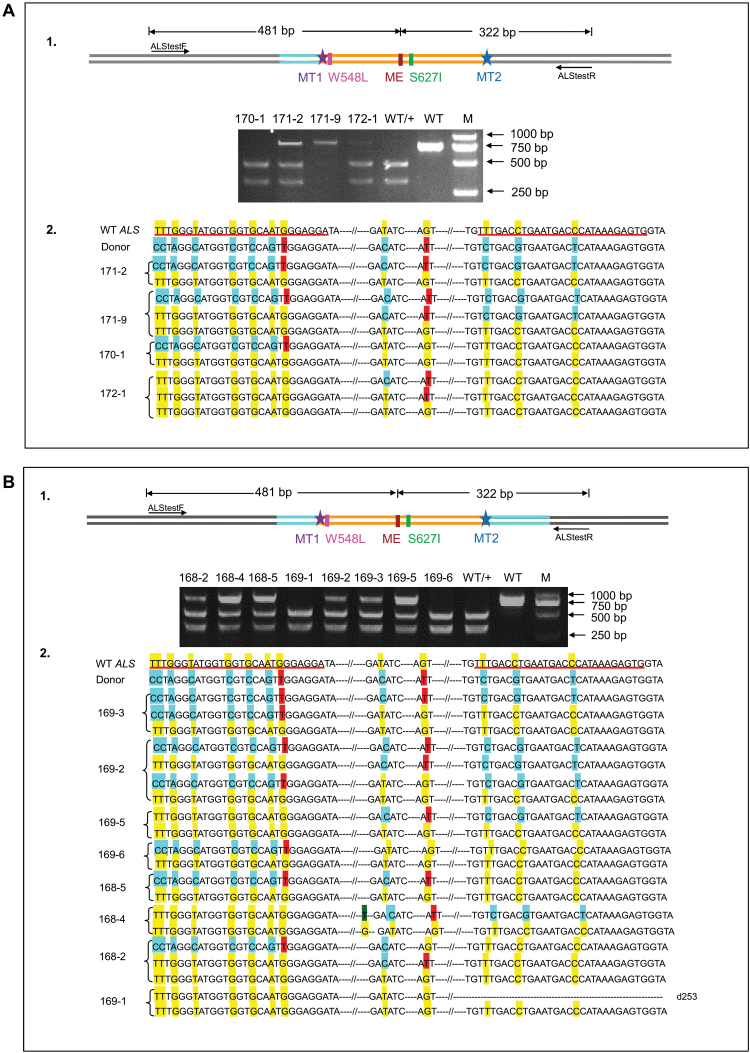Fig. 2.
Generation of stable precisely edited rice lines through SDSA-mediated HDR. (A) Only the left homology arm strategy for CRISPR/LbCpf1-mediated HDR in rice. (A-1) PCR-RE analyses of the different genotypes. PCR products amplified by primers ALStestF/R were digested with EcoRV (GACATC). M, DL2000; WT, wild-type; T1, target 1; T2, target 2; MT1, mutated PAM site and mutated target 1; MT2, mutated PAM site and mutated target 2; ME, mutated EcoRV; WT/+, EcoRV cuts the PCR products of the wild type, resulting in 481 bp and 322 bp fragments. Successful HDR leads to EcoRV-resistant bands. (A-2) Sequence analyses of the HDR events. Line 171-2 has one allele with precise HDR, while the other is wild type. Line 171-9 is a chimeric line with three alleles: a precise HDR, a partial HDR, and a wild type. Line 170-1 has a heterozygous partial HDR. Line 172-1 is a chimeric line with three alleles: one base pair substitution, a partial HDR, and a wild type. The sequences shaded in yellow and blue represent wild-type and the designed donor repair template, respectively. Specifically, the sequences shaded in red indicate the expected targeted substitution. (B) Generation of stable precisely edited rice lines using pCXUN-LbCpf1-OsU3-RCR1-RCR2-armed donor vector through CRISPR/Cpf1-mediated HDR. (B-1) PCR-RE analyses of the different genotypes. PCR products amplified by primers ALStestF/R were digested with EcoRV (GACATC). M, DL2000; WT, wild-type; T1, target 1; T2, target 2; MT1, mutated PAM site and mutated target 1; MT2, mutated PAM site and mutated target 2; ME, mutated EcoRV; WT/+, EcoRV cuts the PCR products of the wild type, resulting in 481 bp and 322 bp fragments. EcoRV failed to digest the PCR products if HDR was successful. (B-2) Representative sequences of the different genotypes. Line 169-3 is a chimeric line with three alleles: one precise HDR, one partial HDR, and a wild type. Line 169-2 is a chimeric line with four alleles: a precise HDR, two partial HDR events, and a wild type. Lines 168-4, 168-5, 169-5, and 169-6 have one partial HDR, except for a synonymous G to T base substitution at position 1911 bp in Line 168-4. The 168-2 is a chimeric line with three alleles. The first and second allele have partial HDR, while the third allele is wild type. Line 169-1 has a 253 bp deletion. The sequences shaded in yellow and blue represent wild-type and the designed donor repair template, respectively. Specifically, the sequences shaded in red indicate the expected targeted substitutions. In d#, the # refers to the number of base pairs deleted from the target sites. Different numbers of lines indicate independent lines developed from resistant calli.

